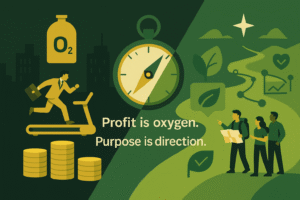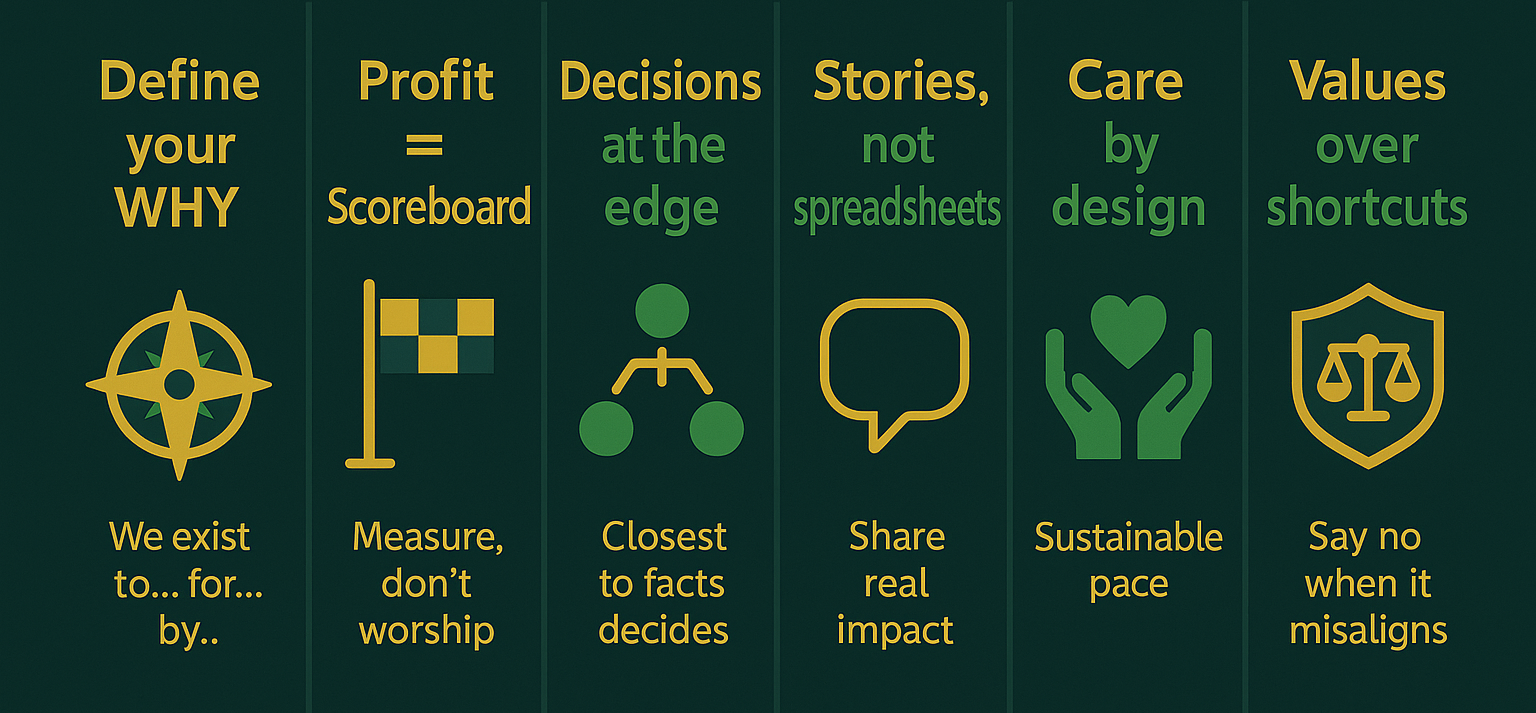Written by Marianne Sepp
Profit is essential – it’s like oxygen. Without it, no organization can survive. But breathing isn’t the purpose of living. If all you ever think about is breathing, you stop living. The same is true in business—when the sole purpose is to make money, it becomes an endless race on a treadmill – faster, higher, more. Profit fuels only more profit. The chase never ends, because there will always be someone with more.
This mindset inevitably comes at a cost: people’s well-being, ethical boundaries, and the limits of our environment. “Winning” in this way is not a real victory. It is a short-term illusion. Employees burn out, customers lose trust, and eventually the world pays too high a price.

Purpose changes the game. Reinventing Organizations reminds us that true success happens when a company is guided by an evolutionary purpose – a deeper “why” behind its existence. Purpose is not a marketing slogan on a website. It is a living force that gives everyday work meaning. It inspires, it empowers, and it brings people together. When individuals feel that their work truly creates value, they tap into an inner motivation far stronger than any bonus or quarterly result.
Make no mistake—profit doesn’t disappear in a purpose-driven organization. But it shifts from being the ultimate goal to becoming the result of serving that purpose well and repeatedly. Companies with a strong sense of purpose attract talent, win the trust of customers, and earn the respect of communities. Their growth is sustainable because it is fueled by meaning, not by fear of missing out.
What purpose does (that profit can’t)
Purpose earns its keep in four ways. First, it gives clarity under pressure. When trade-offs bite, a shared “why” filters choices faster than another layer of approvals. Second, it unlocks intrinsic energy. People work differently when they see how their effort helps someone, not just a KPI. Third, it builds trust you don’t have to buy; customers recognise integrity and stay. And finally, it creates resilience. Teams aligned on purpose need fewer control layers because decisions can move to where the knowledge lives.
As a result, there will be fewer approval hops, decisions are faster and cleaner, teams that know why they are building what they build—and who it helps. Customers who feel the promise, not just the pitch. Profit follows because friction falls, rework drops, and talent stays.
Think of profit like sleeping in a warm bed—vital for rest. Purpose is why you get up: the source of fulfillment and joy that makes us better colleagues, better family members, and even kinder strangers on the street. That’s the value worth creating.
So how do we shift from profit to purpose?
Here are some practical steps inspired by Reinventing Organizations on how to move from profit-chasing to purpose-built without drifting into wishful thinking:
1. Define your “why.”
Ask: Why does this organization exist? What meaningful change do we want to create in the world? Write down one sentence you can’t not stand behind: We exist to… for… by… Make that purpose visible in daily decisions, not just in leadership speeches.
2. Put profit in the right place: the scoreboard, not the aim.
Keep your financials sharp, but track the leading signals that tell you whether purpose is alive: sustainable pace, retention of key people, repeat customers, the impact you aim to have on the community or environment you touch.
3. Empower people with autonomy.
Push decisions to the edge by letting the person closest to the facts decide. Self-managing teams and shared leadership unlock commitment and creativity. People are more engaged when they feel trusted use their expertiese to serve the purpose.
4. Tell stories, not just numbers.
Spreadsheets don’t inspire. Share real stories of how your work has changed lives, helped communities, or solved meaningful problems.
5. Build a culture of care.
Organizations are living systems, not machines. When employee well-being is truly valued, it ripples outward to customers and partners.

6. Stand by your values, even when it’s hard.
Purpose is not just inspiration – it requires courage. Sometimes that means saying no to opportunities that compromise your ethics or harm the planet. In the long run, that integrity strengthens trust and resilience.
Purpose is the only real victory worth pursuing. Profit will follow, but meaning are what last.


